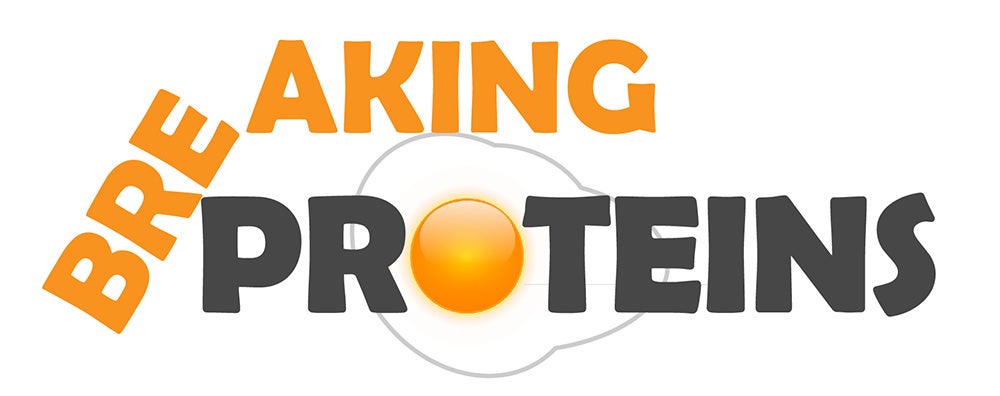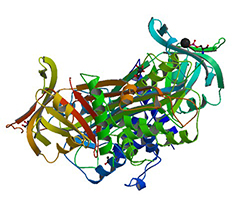
Illustrated by: Karla Moeller
show/hide words to know
Amino acid: molecules that contain carbon, oxygen, hydrogen, and nitrogen. These are the building blocks of protein......more
DNA (deoxyribonucleic acid): molecular instructions that guide how all living things develop and function...more
Molecule: a chemical structure that has two or more atoms held together by a chemical bond. Water is a molecule of two hydrogen atoms and one oxygen atom (H2O)... more
Protein: a type of molecule found in the cells of living things, made up of special building blocks called amino acids.
How to Break Proteins
Overview
Proteins are essential for all living things to function. They are large molecules made up of long chains of amino acids. Depending on the types of amino acids they have, proteins fold in very specific ways. The way they fold controls what the proteins are able to do. Proteins help move other molecules, respond to signals, make reactions happen more quickly, and replicate DNA, among other things. However, if proteins lose their specific folded shape, they are not able to work properly.
Proteins require specific conditions to keep their shape. For example, most proteins in our bodies rely on us to keep a warm (but not hot) body temperature, stay hydrated, and take in enough of specific nutrients like salt. If our bodies aren’t able to maintain these conditions, some of our proteins may not function as well, or at all. Most organisms actually produce special proteins called “molecular chaperones” that help other proteins and molecules continue to work even if conditions are becoming difficult to tolerate.
When a protein is exposed to conditions too far outside of a range it can tolerate, that protein’s shape will come undone. This is called “denaturing” (basically, breaking) a protein. We denature proteins all the time when we cook food (think: eggs). In this activity, we will use common household products or processes to denature egg proteins in two main ways—by cooking them, and by exposing them to concentrated alcohol (ethanol). Do you think egg will look the same or different depending on how the proteins it holds are denatured?
Materials
![]()
- Stove or microwave
- Pot or microwave-safe container to boil water
- 1 fork
- 1 pair scissors
- 1 bowl
- 4 small glass containers of the same size
- 1 egg (split egg white into four parts); additional can be used
- 2/3 cup water (150 ml)
- 1/3 cup of rubbing alcohol (75 ml)
Watch biologist Melissa Wilson Sayres as she shows you step-by-step how to break the proteins in egg whites.

Breaking Proteins in 8 Easy Steps
- Pour 1/3 cup rubbing alcohol into one glass container, room temperature water (1/3 cup) into another, and the rest of the water (1/3 cup) into a microwave-safe container (or into a pot).
- Crack egg into the bowl, removing the yolks.
- Cut the egg white into pieces so you can add ¼ into each glass container.
- Heat up the water for your hot water treatment and pour into one of the empty glass containers.
- Quickly put ¼ of the egg yolk into the boiling water. Then put ¼ into the alcohol, ¼ into the room temperature water, and the remainder into the final, empty glass container.
- Observe any immediate changes that occur in terms of egg white color and consistency. If you try stirring the different treatments, rinse your fork between stirs.
- Wait for 30 minutes.
- Use the fork to inspect the state of the egg whites in each treatment and note how they may have changed over time.
(Teacher & Student packet is available).
What Happened?
Why does denatured egg white turn from clear to white? If more than one treatment denatured egg whites, do you think the treatments denatured the egg whites in the same way?
Let’s look at each of the treatments we used:
- Control. Egg whites start out clear. They are almost 90% water, but the other 10% is packed with proteins. Egg whites contain more than 50% of the proteins found in the egg. The main protein in egg white is called albumin. The small, folded proteins in the egg white don’t take up much space, and the gel-like egg white looks clear. The control egg showed us that, when left at room temperature, the egg whites stay clear, meaning the proteins maintain their original shape. These proteins were not denatured.
- Cooking (hot water).Whenever eggs are cooked with heat, the egg whites turn from clear to white, and the gel becomes more rubbery. As heat denatured the proteins in the egg white, it broke apart some of the bonds (mostly hydrogen bonds) that were holding the proteins in their original shape. The proteins unfolded, taking up more space (turning the gel white) and hardening them in place next to one another.
- Alcohol. Alcohol also denatures proteins. It does this the same way as heat, by breaking the bonds that hold parts of the protein in a folded shape. Sometimes the alcohol molecules bond directly to some of the parts of the protein, disrupting the normal way the protein would bond to itself. (So alcohol is called a “bond disruptor.”) The proteins again unfolded, taking up more space and hardening in place next to one another. This process took much longer with alcohol than it did with heat, however. The longer time for denaturation with alcohol is simply because it spreads more slowly than heat. The alcohol had to diffuse (or move through the fluid) into the egg in order to affect the proteins it touched.
- Room temperature water. Sometimes in this experiment, room temperature water has a small denaturing effect on some of the egg white. It acts in the same way, by breaking bonds, but its effect isn’t nearly as strong as alcohol or hot water.
Questions to think about after denaturing egg proteins
Think about the effects of the two different water treatments. Do you think the water itself was denaturing proteins? If not, what was? If so, what was having the larger effect between the water treatments?
Are there any other processes you know of that turn egg whites from clear to white? What is it and do you think the same processes are happening?
Name another condition besides heat and exposure to a bond disruptor (like alcohol) that could affect the ability of a protein to maintain its shape.
What other things change color when their proteins are denatured?
Why might a living organism want to keep their proteins from denaturing?
In this activity, why was it important to have egg whites that we did not cook or add alcohol to?
Additional images via Wikimedia Commons. Soft-boiled egg by H. Alexander Talbot.
View Citation
Bibliographic details:
- Article: Breaking Proteins
- Author(s): Karla Moeller
- Publisher: Arizona State University School of Life Sciences Ask A Biologist
- Site name: ASU - Ask A Biologist
- Date published: May 29, 2018
- Date accessed: April 17, 2024
- Link: https://askabiologist.asu.edu/activities/breaking-proteins
APA Style
Karla Moeller. (2018, May 29). Breaking Proteins. ASU - Ask A Biologist. Retrieved April 17, 2024 from https://askabiologist.asu.edu/activities/breaking-proteins
Chicago Manual of Style
Karla Moeller. "Breaking Proteins". ASU - Ask A Biologist. 29 May, 2018. https://askabiologist.asu.edu/activities/breaking-proteins
Karla Moeller. "Breaking Proteins". ASU - Ask A Biologist. 29 May 2018. ASU - Ask A Biologist, Web. 17 Apr 2024. https://askabiologist.asu.edu/activities/breaking-proteins
MLA 2017 Style

When an egg is cooked, the clear liquid surrounding the orange yolk becomes more solid and white. What causes this to happen?
Be Part of
Ask A Biologist
By volunteering, or simply sending us feedback on the site. Scientists, teachers, writers, illustrators, and translators are all important to the program. If you are interested in helping with the website we have a Volunteers page to get the process started.







